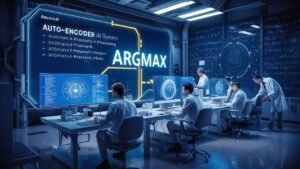The phrase “argmax only supported for AutoEncoderKL” refers to a specific implementation detail in deep learning models, particularly those involving AutoEncoderKL, a type of neural network architecture used for tasks like data compression, representation learning, and generative modeling. This article explores the significance of this limitation, its implications, and how to work effectively within this constraint.
Understanding AutoEncoderKL
AutoEncoderKL (Kullback-Leibler AutoEncoder) is a variant of the traditional autoencoder that incorporates a probabilistic framework. Unlike conventional autoencoders, which compress input data into a deterministic latent space, AutoEncoderKL models the latent space as a probability distribution. This is achieved by introducing a Kullback-Leibler divergence term in the loss function, which ensures that the learned latent space approximates a predefined distribution, usually Gaussian.
This probabilistic approach is critical for applications such as:
- Generative Modeling: AutoEncoderKL is commonly used in variational autoencoders (VAEs) for generating new data samples similar to the training data.
- Uncertainty Quantification: By modeling a distribution in the latent space, AutoEncoderKL allows capturing uncertainty in predictions.
- Improved Representation Learning: The probabilistic nature encourages disentanglement in the latent representations, making them more informative and generalizable.
The Role of Argmax in Neural Networks
Argmax only supported for autoencoderkl is a mathematical function that identifies the index of the maximum value in a given array or tensor. In the context of neural networks, argmax is often used to:
- Classify Predictions: In classification tasks, argmax helps identify the class with the highest probability in the output layer.
- Selection Mechanisms: Argmax is used for selecting specific features or tokens in reinforcement learning and sequence modeling tasks.
- Discrete Sampling: It enables converting continuous probability distributions into discrete decisions, such as token generation in natural language processing (NLP).
However, using argmax within models like AutoEncoderKL can introduce challenges due to its discrete and non-differentiable nature, making it incompatible with gradient-based optimization methods.
Why Argmax is Limited to AutoEncoderKL
The limitation of argmax being “only supported for AutoEncoderKL” arises from the architectural and functional constraints of AutoEncoderKL. These include:
- Non-Differentiability: The argmax operation is inherently non-differentiable, which clashes with the gradient-based optimization techniques used to train neural networks. AutoEncoderKL, however, incorporates workarounds like reparameterization to allow such operations in specific contexts.
- Probabilistic Framework: AutoEncoderKL’s probabilistic latent space requires operations that preserve the distributional structure. Argmax, being a hard selection mechanism, might disrupt this framework if not handled carefully.
- Implementation-Specific Constraints: Certain deep learning libraries or frameworks may restrict the use of argmax within models like AutoEncoderKL to ensure numerical stability and compatibility with training algorithms.

Implications for Practitioners
For researchers and practitioners, this limitation means adapting their workflows to accommodate these constraints. Key considerations include:
- Using Alternative Operations: Replace argmax with softmax or other differentiable approximations during training to ensure compatibility with gradient-based optimization.
- Reparameterization Tricks: Utilize reparameterization techniques, such as the Gumbel-Softmax trick, to approximate argmax while maintaining differentiability.
- Framework-Specific Guidelines: Familiarize yourself with the specific requirements and constraints of the deep learning library being used, as these can impact how operations like argmax are implemented.
Exploring Alternatives to Argmax
While the direct use of argmax within AutoEncoderKL is constrained, there are effective alternatives that align better with the architecture’s probabilistic and differentiable nature:
- Softmax Approximation: The softmax function provides a smooth approximation to argmax by converting logits into probabilities. By adjusting the temperature parameter, practitioners can control the sharpness of the distribution, effectively mimicking the behavior of argmax without breaking differentiability.
- Sampling Techniques: Stochastic sampling methods, such as sampling from a categorical distribution, allow for discrete selections while maintaining compatibility with the probabilistic framework of AutoEncoderKL. These methods are often paired with reparameterization tricks to ensure gradients can still propagate.
- Hybrid Approaches: Combining argmax with post-processing steps can sometimes bypass its limitations. For instance, argmax can be used during inference while relying on soft approximations or sampling techniques during training.
Future Directions and Research Opportunities
The challenges posed by the argmax limitation in AutoEncoderKL highlight broader questions about the interplay between discrete operations and differentiable learning frameworks. Future research could explore:
- Improved Reparameterization Methods: Developing new techniques that better approximate discrete operations like argmax while preserving differentiability.
- Architectural Innovations: Designing neural network architectures that natively support discrete operations without compromising on optimization capabilities.
- Application-Specific Optimizations: Tailoring solutions to specific use cases, such as natural language processing or computer vision, where the need for argmax-like behavior is more pronounced.
Conclusion
Understanding the limitation of argmax support in AutoEncoderKL is crucial for effectively utilizing this architecture in deep learning tasks. By appreciating the underlying principles, exploring alternatives, and adhering to best practices, practitioners can overcome these constraints and unlock the full potential of AutoEncoderKL in their projects. Furthermore, ongoing research and innovation in this area promise to expand the capabilities of deep learning models, bridging the gap between discrete and continuous operations for a wider range of applications.